Theo Akkermann
Theo Akkermann (1 November 1907 – 1 August 1982) was a German sculptor who focused on public sculptures in churches and cemeteries. He held teaching positions at the University of Pretoria and in Ghent, Belgium.
Theo Akkermann | |
|---|---|
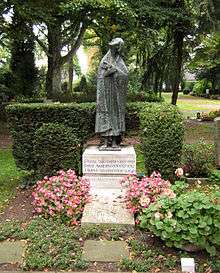 Grave of the Akkermann family in the main cemetery of Krefeld | |
| Born | 1 November 1907 |
| Died | 1 August 1982 (aged 74) Krefeld |
| Education |
|
| Occupation |
|
Life
Akkermann and his twin sister Sabine were born in Krefeld,[1][2][3] the children of Hermann Akkermann and Sabina Becker.[1] He studied at the Kunstgewerbeschule in Krefeld and at the Hamburger Kunstakademie from 1926 to 1929, although he planned to become an engineer.[1] Deciding in the end to focus on the arts, he studied at the École nationale supérieure des Beaux-Arts of Paris from 1929 to 1931, working at the studio of Jakob Mellen in Hüls during vacation times.[1] His first major work was a war memorial for the victims of World War I, unveiled at the cemetery of Nieukerk in Kerken in 1932.[1][4] Akkermann studied further at the Academy of Arts, Berlin, with Hugo Lederer and Fritz Klimsch in 1932/33.[1] Back in Krefeld, he married Adele Bieger in 1942, and the couple had three chilren.[1]
Many of Akkermann's works were destroyed by bombing in World War II.[3] In 1950, Akkermann became a professor and head of a sculpture class at the University of Pretoria in South Africa.[3] From 1957 he worked as a professor in Ghent, Belgium.[2]
Akkermann's twin sister also became a sculptor whose works are shown in public space.[2] He died in Krefeld in 1982.[5]
Works
Akkermann created large sculptures for public spaces, especially Christian art and monuments for churches and cemeteries.[3] His early war memorial for the cemetery in Kerken shows larger-than-lifesize figures of six soldiers carrying the coffin of a comrade.[4] He designed the interior of the Autobahnkapelle Geismühle near Krefeld, including a large bronze sculpture instead of an altar.[6]
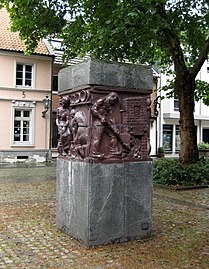 Pottbäcker Denkmal
Pottbäcker Denkmal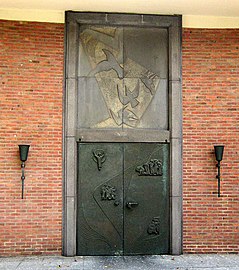 Portal of cemetery chapel in Krefeld-Hüls, 1958
Portal of cemetery chapel in Krefeld-Hüls, 1958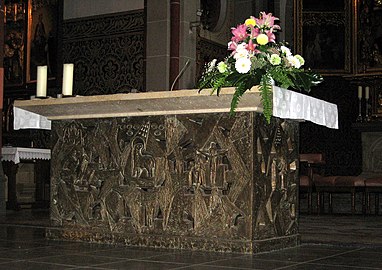 Altar, St. Cyriakus Krefeld-Hüls
Altar, St. Cyriakus Krefeld-Hüls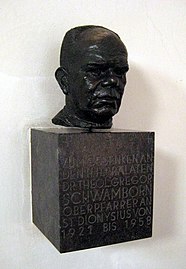 Bronze bust of Gregor Schwamborn, St. Dionysius, Krefeld
Bronze bust of Gregor Schwamborn, St. Dionysius, Krefeld Crucifix, Hauptfriedhof, new part, Krefeld
Crucifix, Hauptfriedhof, new part, Krefeld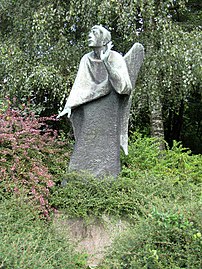 Angel of Peace, Krefeld-Inrath
Angel of Peace, Krefeld-Inrath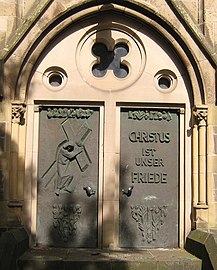 Portal of the Pauluskirche, Krefeld
Portal of the Pauluskirche, Krefeld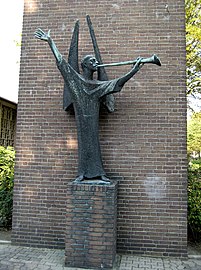 Angel with Trumpet, Erlöserkirche Krefeld-Lindental
Angel with Trumpet, Erlöserkirche Krefeld-Lindental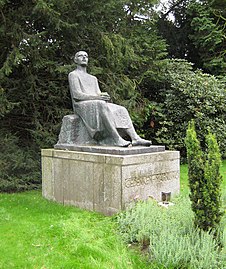 Ehren- und Mahnmal Krefeld-Fischeln
Ehren- und Mahnmal Krefeld-Fischeln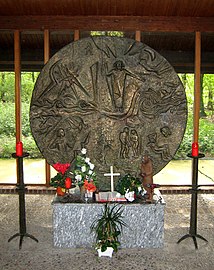 Bronze sculpture, Autobahnkapelle Geismühle
Bronze sculpture, Autobahnkapelle Geismühle
References
- Opdenberg, Birgit; Opdenberg, Georg. "KunstRaum Krefeld / Porträts Theo Akkermann 1907 – 1982 / Bildhauer" (PDF). kunstundkrefeld.de (in German). Retrieved 19 June 2020.
- "Skulpturen bis ins ferne Kapstadt". Westdeutsche Zeitung (in German). 9 November 2007. Retrieved 19 June 2020.
- Fehrmann, Chrismie (15 May 2020). "Kultur trotz Corona / Ein Akkermann gehört nicht ins Museum". Westdeutsche Zeitung (in German). Retrieved 19 June 2020.
- "Kerken-Nieukerk, Kreis Kleve, Nordrhein-Westfalen:". denkmalprojekt.org (in German). Retrieved 19 June 2020.
- "Theo Akkermann". Kunst im öffentlichen Raum in Hagen (in German). Retrieved 19 June 2020.
- Tückmantel, Ulli (2019). Gott to go: Das Autobahnkirchen-Buch fürs Handschuhfach (in German). BoD. p. 135. ISBN 978-3-73-476720-3.
External links
| Wikimedia Commons has media related to Theo Akkermann. |
- Literature by and about Theo Akkermann in the German National Library catalogue
- Theo und Sabine Akkermann (in German)
- Widbert Felka: Die Kaltwalzer-Skulptur vor den Toren der Firma Bilstein (in German) in: Hohenlimberger Heimatblätter, October 2002
- Photo: Kriegs-Opfer - Ehrenmahl, auf dem Friedhof in Niuekerk. (in German) tripadvisor.com 2019
- Wachtendonk / Kriegerdenkmal statues.vanderkrogt.net